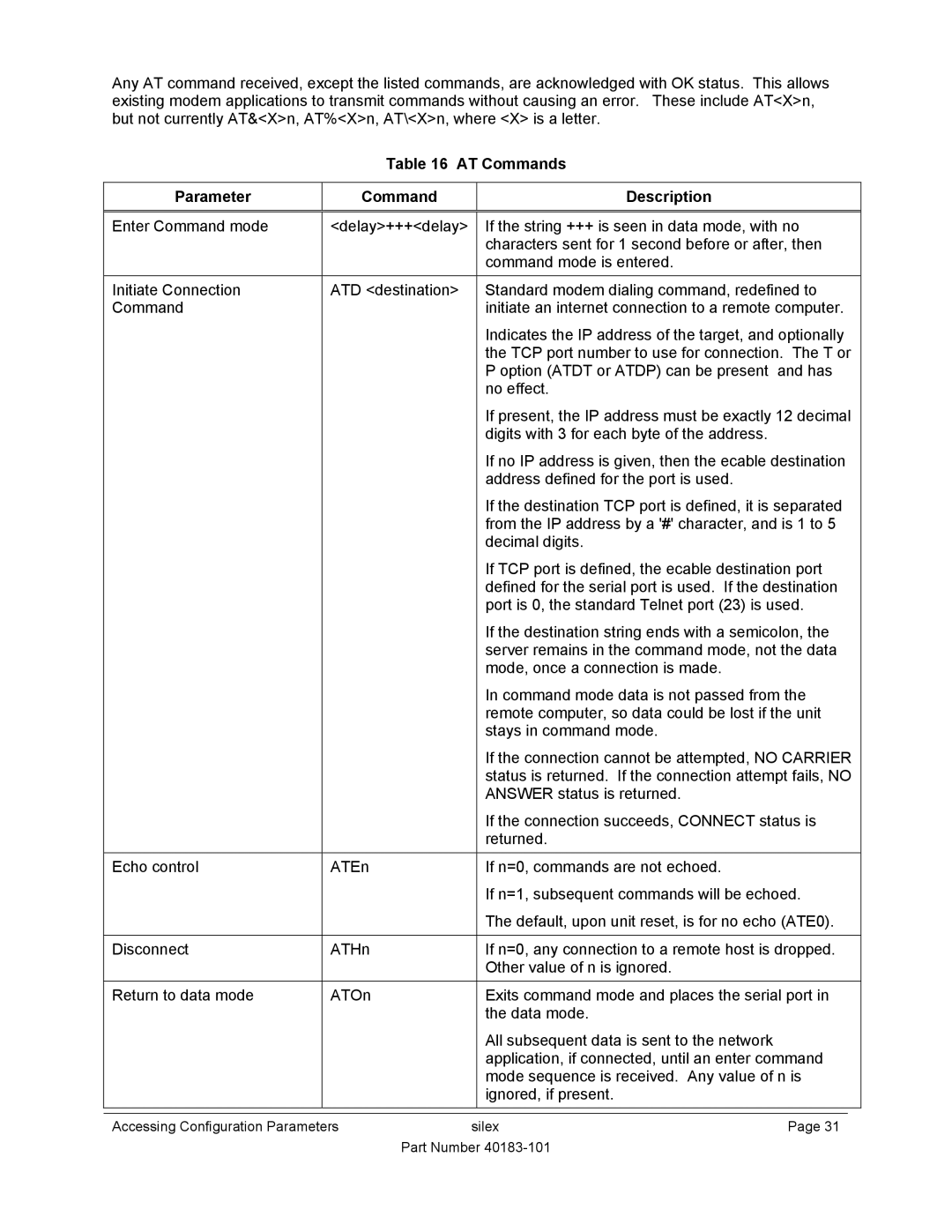
Any AT command received, except the listed commands, are acknowledged with OK status. This allows existing modem applications to transmit commands without causing an error. These include AT<X>n, but not currently AT&<X>n, AT%<X>n, AT\<X>n, where <X> is a letter.
Table 16 AT Commands
Parameter
Command
Description
Enter Command mode | <delay>+++<delay> |
| If the string +++ is seen in data mode, with no | ||
|
|
| characters sent for 1 second before or after, then | ||
|
|
| command mode is entered. |
|
|
|
|
|
| ||
Initiate Connection | ATD <destination> |
| Standard modem dialing command, redefined to | ||
Command |
|
| initiate an internet connection to a remote computer. | ||
|
|
| Indicates the IP address of the target, and optionally | ||
|
|
| the TCP port number to use for connection. The T or | ||
|
|
| P option (ATDT or ATDP) can be present and has | ||
|
|
| no effect. |
|
|
|
|
| If present, the IP address must be exactly 12 decimal | ||
|
|
| digits with 3 for each byte of the address. |
|
|
|
|
| If no IP address is given, then the ecable destination | ||
|
|
| address defined for the port is used. |
|
|
|
|
| If the destination TCP port is defined, it is separated | ||
|
|
| from the IP address by a '#' character, and is 1 to 5 | ||
|
|
| decimal digits. |
|
|
|
|
| If TCP port is defined, the ecable destination port | ||
|
|
| defined for the serial port is used. If the destination | ||
|
|
| port is 0, the standard Telnet port (23) is used. | ||
|
|
| If the destination string ends with a semicolon, the | ||
|
|
| server remains in the command mode, not the data | ||
|
|
| mode, once a connection is made. |
|
|
|
|
| In command mode data is not passed from the | ||
|
|
| remote computer, so data could be lost if the unit | ||
|
|
| stays in command mode. |
|
|
|
|
| If the connection cannot be attempted, NO CARRIER | ||
|
|
| status is returned. If the connection attempt fails, NO | ||
|
|
| ANSWER status is returned. |
|
|
|
|
| If the connection succeeds, CONNECT status is | ||
|
|
| returned. |
|
|
|
|
|
|
|
|
Echo control | ATEn |
| If n=0, commands are not echoed. |
|
|
|
|
| If n=1, subsequent commands will be echoed. | ||
|
|
| The default, upon unit reset, is for no echo (ATE0). | ||
|
|
|
| ||
Disconnect | ATHn |
| If n=0, any connection to a remote host is dropped. | ||
|
|
| Other value of n is ignored. |
|
|
|
|
|
| ||
Return to data mode | ATOn |
| Exits command mode and places the serial port in | ||
|
|
| the data mode. |
|
|
|
|
| All subsequent data is sent to the network |
|
|
|
|
| application, if connected, until an enter command | ||
|
|
| mode sequence is received. Any value of n is | ||
|
|
| ignored, if present. |
|
|
|
|
|
|
|
|
Accessing Configuration Parameters | silex | Page 31 | |||
Part Number
